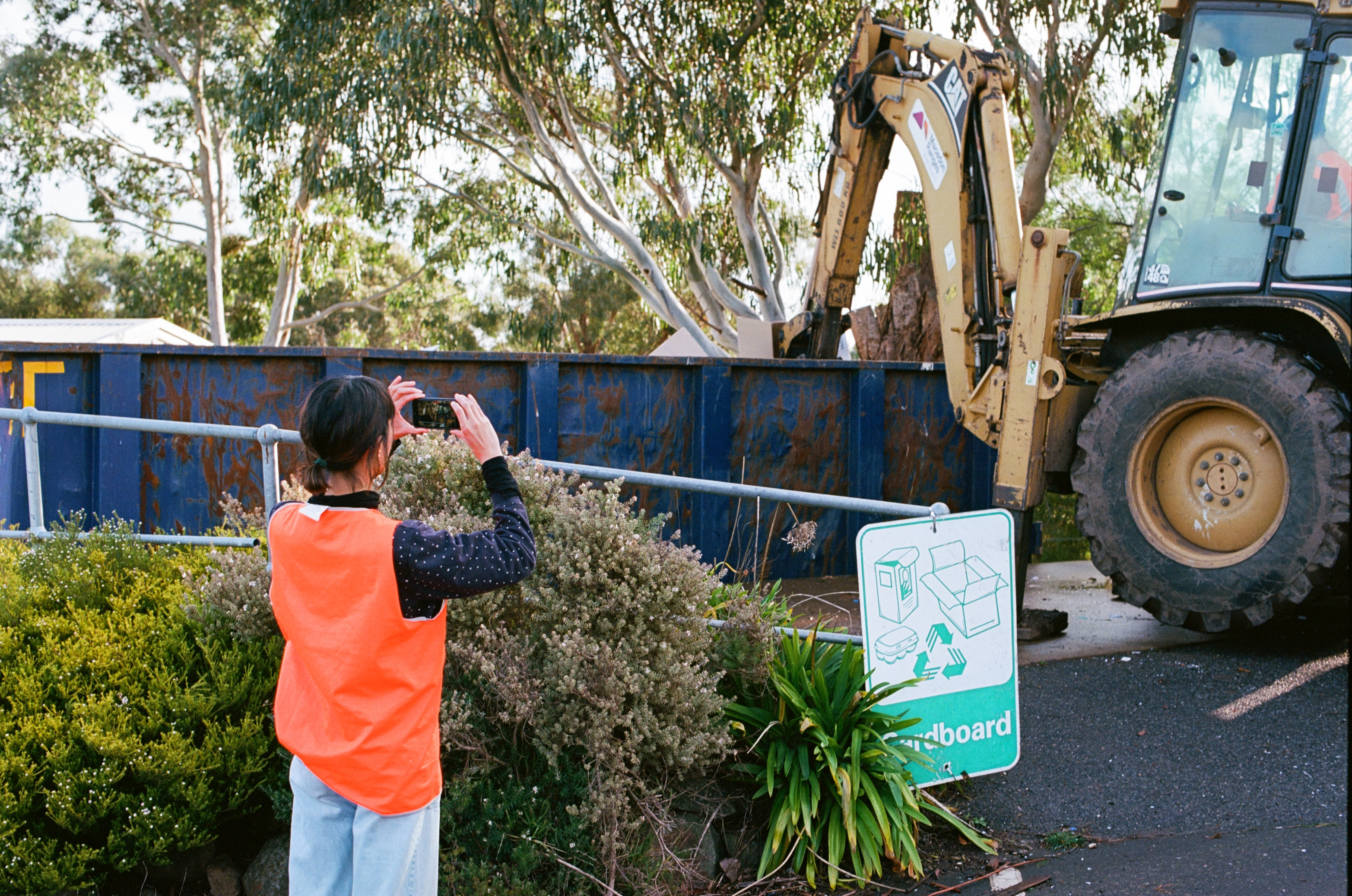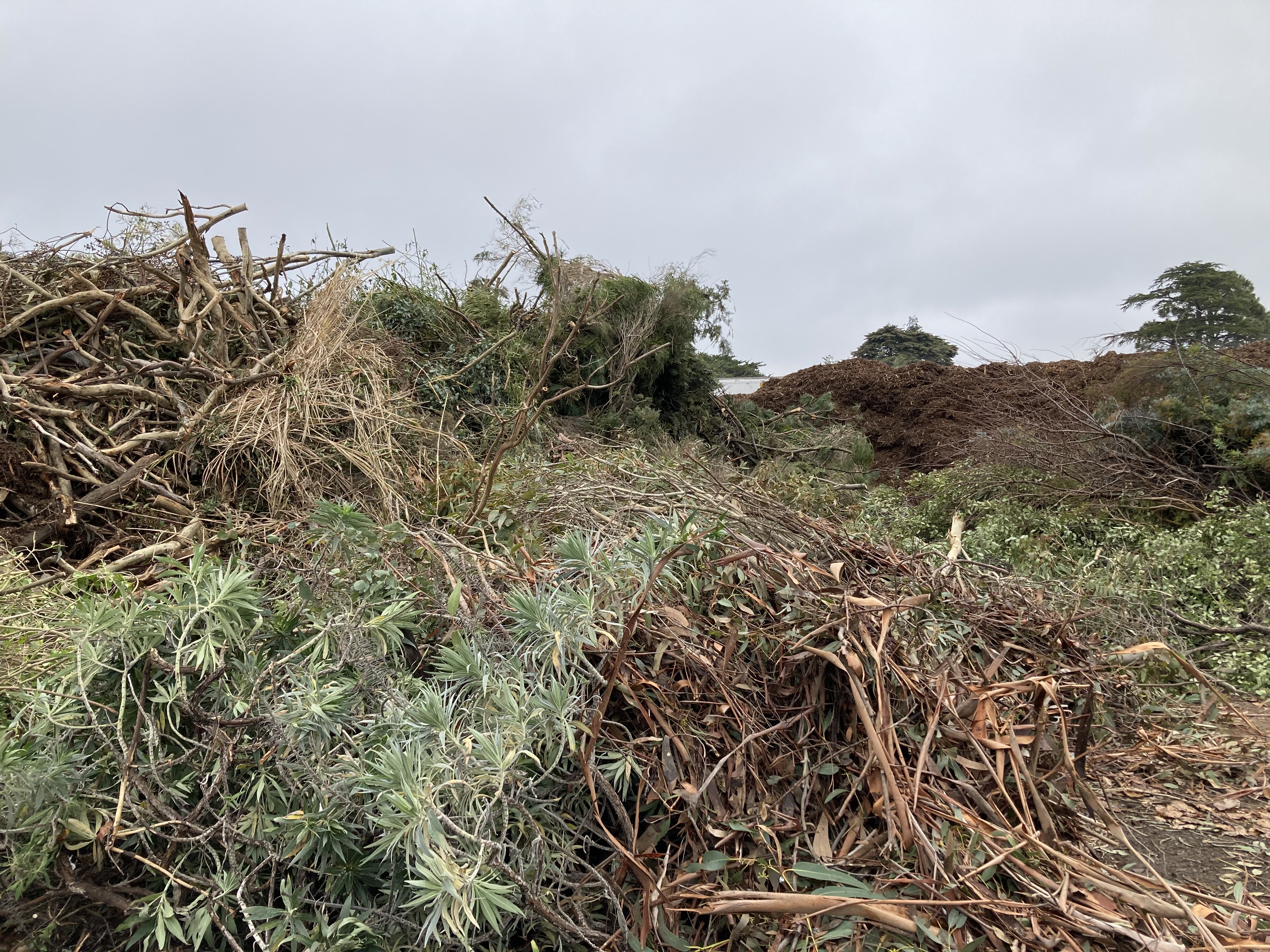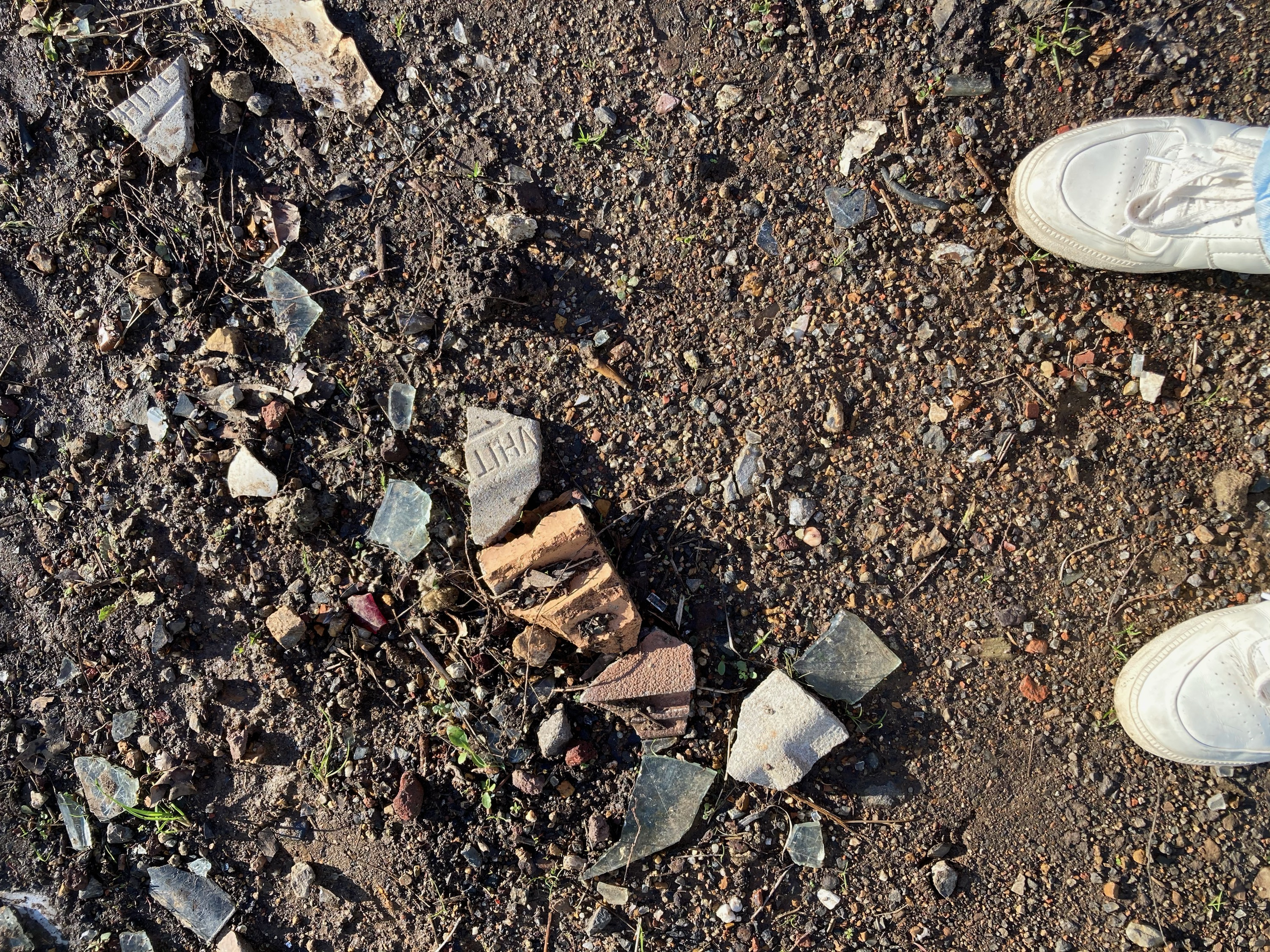Eugenia Lim works across body, lens, social and spatial practice to explore how national identities, migration and capital cut, divide and bond our interdependent world. Her work imagines a world in which pluralism and solidarity are the common ground, a place where people are curious about each other instead of afraid.
Shelters for Kyneton (triadic transfer) by contemporary artist Eugenia Lim documents a series of performative interventions into Kyneton’s transfer station, or ‘tip’. Inspired by the ‘work ballets’ of Mierle Laderman Ukeles, the work considers maintenance, care and ecology in the settler-colonial context of contemporary Kyneton, and the knowledges and learned choreographies different bodies hold. The work features Lim alongside two key members of the local community, Macedon Ranges Shire Council Mayor Cr. Jennifer Anderson, and transfer station worker Steve Boulter, activating wearable ‘shelters’ as sites of collective action, flows and ecology.
The following is a conversation between Project Producer Angela Connor and Eugenia Lim about her upcoming video work for KCAT 2021.
AngelaI’d like to talk about your proposed video work at the Kyneton Transfer Station. I know that so many elements are still in flux but I thought I’d begin with the question of how you approach a curatorial brief that is so much about embedding the work in a town?
EugeniaI’ve visited Kyneton a few times and was really interested in making work that responded to the site and the context, which is the remit of KCAT, and that excited me a lot. I didn’t have a predetermined idea in mind, but when I finally got to visit, which was delayed through lockdowns and the tumult of last year, there were a couple of sites that really spoke to me. One of those was the  Transfer Station1, which is where recycling and waste from the town goes to die or to live again.
Transfer Station1, which is where recycling and waste from the town goes to die or to live again.
It’s not a very glamourous site and it’s in the industrial-outer of the town. It fascinated me because every household in Kyneton has some interface with it, either through their (file or url not found)2 or their recycling. Or they might go and get  mulch3 for their garden, for example. It’s somewhere that probably isn’t considered part of daily life but actually connects every household to the life-ways of the town. So, when I went out to the Transfer Station, that’s where the idea really sparked! How could this site on the periphery, but also very much at the centre of the cycle of Kyneton’s systems be celebrated as somewhere where (file or url not found)4 is happening.
mulch3 for their garden, for example. It’s somewhere that probably isn’t considered part of daily life but actually connects every household to the life-ways of the town. So, when I went out to the Transfer Station, that’s where the idea really sparked! How could this site on the periphery, but also very much at the centre of the cycle of Kyneton’s systems be celebrated as somewhere where (file or url not found)4 is happening.
ACI like the idea behind your choice of using the Transfer Station and your decision to work with a site that interweaves humanity, ecology and the town. Particularly seen during the last eighteen months, the importance of the maintanence worker has been emphasised.
ELMaking visible these systems or honoring the work that is happening to keep the town going was in my mind and links back to one of my art heroes Mierle Laderman Ukeles.1 Ukeles is a US-based artist who has worked with the New York Sanitation Department for forty years, unsalaried and as an artist-in-residence with their department. She has a desk on-site. She’s been working with the sanitation people—the people that keep New York city alive—and I’ve long been inspired by the way that she uses art to bring quite diverse communities together. For Ukeles, art isn’t something that needs a special time and place— it’s happening everywhere, all the time. I really love that idea that we can bring art into everyday life and outside the gallery context.
It’s funny; when we did the site visit the first time, I noticed that the Transfer Station is next to the cemetery. And it’s like this interesting life-cycle—mortality, planned obsolescence—all these things happening in close proximity. Read together, they are both funny and dark, but also really matter of fact at the same time. I really like how all that can be happening at once. I think that if the work can be made and exhibited there, it says, this is part of our town. It’s part of our working ecology. I like that maybe the site can be seen anew and celebrated in that way.
-
Mierle Laderman Ukeles, Wikipedia accessed 4 July, 2021 ↩
ACIt’s been interesting watching the development of this work.
ELThere have been so many barriers, and so many big complex issues like being in lockdown in Melbourne for nine months, and some huge obstacles that I’ve been facing this past eighteen months. Within this project I’ve been constantly needing to adapt and to find agility in difficult circumstances.
ACWith past projects, and thinking about this project, do you like to work with a level of ambiguity where so many elements are up in the air or do you usually work within a rigid structure?
ELThe way that I generally make videos is a balance between quite strict parameters, planning and logistics, for example locking in costumes and sites; but then allowing for chance and spontaneity and the living context of the site and of the people that are moving through those spaces to manifest in the work. A previous project The Australian Ugliness (2018)1 shares a lot with this project, even though in that case, there was three years of planning and thirty-five locations that were locked in. That work was very much about allowing performers to intervene in sites like the Sydney Opera House or the Sirius Building, and allowing this persona or being that shouldn’t normally be there to enact change or disruption in the sites.
I’m quite used to setting things up and allowing the unknown to unfold. I like the tension between planned, rehearsed and reframed, and chance. That’s why performance so often comes into my work, because I can’t control everything. And living in a pandemic, nothing feels within my control. I’ve had to embrace that with this project and try to set things up as much as I can, while leaving things open to change. Visiting the Transfer Station, meeting with the Mayor, and working with local council to bring them on board. Which is also what Ukeles does—working creatively within infrastructure to bring these social practices into what is generally seen as quite ‘dry’ maintenance systems, and reframing these as sites of creativity.
-
The Australian Ugliness, 2018, three-channel video installation with six-channel audio, 33:58 mins loop, installation design by WOWOWA, Melbourne School of Design (2018), Museum of Contemporary Art Sydney (2019), Samstag Museum of Art, Adelaide (2019) ↩
ACWith this project how do you navigate working with so many unknowns?
ELI think there will continue to be unknowns until the end, it’s just the nature of the current situation. I’ve had to embrace this and think about how I can build a gentle process into the making of the work, which is why I’m bringing on long-time collaborators like (file or url not found)1 and Tim Hillier who both work between video and performance. Both of these artists understand my language and my way of working. With so many external question marks, there is a consistency of trust and a language that’s been built up over a number of years that can sustain that level of uncertainty and having to work on the fly. It’s definitely challenging and a bit scary, but I think there’s often that aspect of improvisation in my work. I just have to welcome that at this time.
-
Zoe Scoglio, Site Visit, Kyneton Transfer Station, June 30, 2021 ↩
ACWhen I visited your studio at Collingwood Yards a few months ago, you mentioned that when you start a project the parameters are quite wide and often you’re surprised that people say yes.
ELI think with art and working with community, you are often surprised, even when you think that there’s no way they will say ‘yes’. I think when there’s a spirit of generosity, or that spirit of, hey I don’t really know but how about we learn together, it almost becomes a dance where you learn the steps together and create something which is a bit unfamiliar but a beautiful process of negotiating back and forth. I hope with a project like this, making it public and sharing it with the local community, people will respond to it, even if they’re not from an art background. Everyone wants to connect with others, especially through these times, so there is no harm in asking.
ACArt definitely gives artists the opportunity to work outside the realms of the daily experience and to connect with the community in ways outside the norm.
ELI think so. It’s about this space and a dialogue. I’m learning as much from you as you are from me. From my perspective I’m probably learning more than you are. I think people respond to that.
ACHow much authorship or direction do you give the participants in your work?
ELIn the lead-up to working with someone, I always try and offer as much information and transparency as I can. Say for example with the Transfer Station, the brief really is talking, learning and engaging with potential workers/participants about what they do in a day, what those actions may be, and the different areas of work and the different materials – like the glass and the electronics that get recycled on-site. In my other collaborations that I have done to date with other kinds of on-demand workers, often the work and the movement comes out of our conversations, learning about what the job is, or how they feel in these different economies and engagement with customers. That becomes the thing that structures the work in a lot of ways. With the Transfer Station, it’s been a strange process where I’ve only had one site recce  (now two)1 and fell in love with the site. Until now, I haven’t had the opportunity to go back. A stop-start with a lot of gaps.
(now two)1 and fell in love with the site. Until now, I haven’t had the opportunity to go back. A stop-start with a lot of gaps.
I try to learn from my collaborators about what they do and build that into the movement we film. I think in terms of authorship and negotiating those things, it’s always a delicate process. I’m really mindful of people allowing me into their workspaces so I guess it’s that balance. I’m asking them to do something that’s potentially quite strange and uncomfortable, coming into the contemporary art space, but at the same time, we’re filming on a site that is quite known and familiar to them. I’m the one that’s the outsider. I hope there is some sense of everyone working within what they know but also being open to things being a bit strange or new.
-
Eugenia Lim, Site Visit, Kyneton Transfer Station, 30 June, 2021 ↩
ACLet’s talk about the gold bling and the proposed outfit that the participants will wear.
ELSure. I’ve worked for a number of years with this material called Mylar, which is this gold emergency blanket that’s used in camping and survival. You see it in the news, when refugees are rescued at sea. It has a dual function of being about survival but also fragility, seeking of shelter and of basic human rights that a lot of us take for granted. I’ve been drawn to this duality and tension for a number of years. It’s a material that I used in a previous work in 2015, then since then, it’s popped up in a few of my projects.
The project for KCAT is called Shelters for Kyneton and it’s (sort of) a continuation of a project that I made back in 2015 called Shelter.1 That work was looking at ideas of humanitarian architecture and what it means to survive in our quite privileged and safe context of Australia versus what it means to survive in refugee contexts and the huge disparity between those two things. The work for Kyneton is in response to this very fraught pandemic moment, trying to make a work that is about coming together and connecting again. How can this Shelters project be a site for connection and collectivity? Instead of making these architectural shelters in the town, which was what the original project in 2015 was, it’s more about wearable architectures that hopefully activate the site and the participants and make it more centred and visible to the town. The costume, three gold Mylar jumpsuits, is connected by one arm, so we have to work together in order to do anything—three individuals working together in a collective body.
-
Shelter, 2015, Performance over two days, Grey Gardens, Melbourne ↩
ACI recently watched via your website your work On Demand (2019). How much emphasis do you put on affecting the behaviour of the audience through your work and art as a tool for affecting social change?
ELI can’t ever presume that my work has a lasting affect, but I hope that it resonates. With On Demand1, it was consciously a work that set out to make the viewer physically ‘work’ and use their body. It’s a pedal-powered video installation, so the viewer has to work to trigger the video. I really wanted to point out the general passivity of art-viewing and the visual art world – you put a video in a space and it’s generally a one-way thing. Of course, the audience have some agency over how long they spend in the space, but they don’t have to necessary put themselves on the line to engage with something. On Demand is about on-demand work, and these workers work with physical risk and their body is their labour, so I wanted to ‘outsource’ that onto the viewer. With the Kyneton work it feels important to also be performing alongside the other two collaborators.
As to the long-term affect, I don’t kid myself that I’m an activist. Art is not direct action by any means. It’s a context that the general public won’t see. What appeals to me about KCAT and projects like this is they’re projects about and for the local community and context. I like working across contexts and across the gallery space, but I love testing my ideas. You get that with performance work or working with community because it’s so direct. When you’re making work like this, it is about communicating beyond disciplines or beyond certain contexts or demographics, and it’s about asking something and seeing what comes back. I guess, the long-winded answer to that question is, I like to set up situations where people can access things that are familiar in an unfamiliar or new way.
-
On Demand, 2019, pedal-powered 4K four-channel video installation, stereo sound, 14:00 min ↩
ACIn the familiar, you also tackle some really big questions.
ELSo many things that I work on are big languages or questions or ideas that engage us all on a daily basis—whether it’s architecture or smartphones or the digital economy. These are all things that we use but we don’t necessarily stop to think about the ethical conundrums around them. I think I am working in that space where I am trying to work through the ethical conundrums. I’m feeling complicit in something so I’m trying to use the project as way to work through that. I figure that if I feel ethically disturbed or uncomfortable about something, chances are that other people do too. And it becomes a way to navigate those questions together in a way that isn’t preachy or self-righteous. I think, hey, these are urgent questions we shouldn’t just sleepwalk into. How about we try and work through them in ways that are funny, but also aesthetic and sensory. I feel that if you can invite people in through humor or the sensory, you can then go deeper to ask more difficult questions.
Footnotes